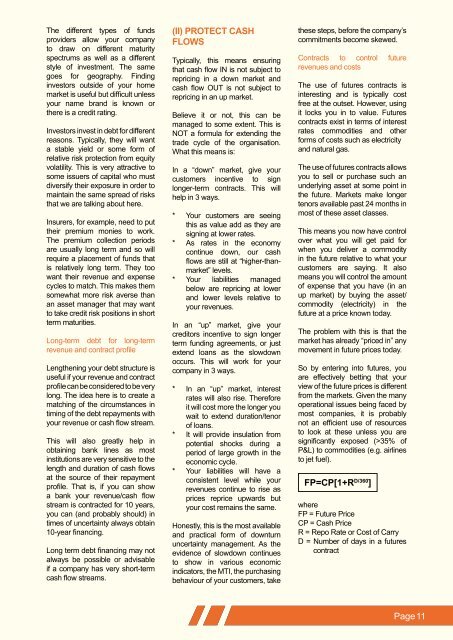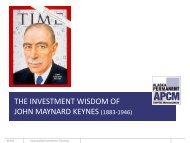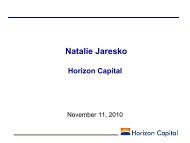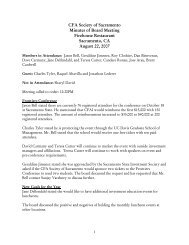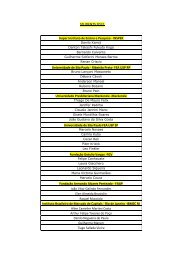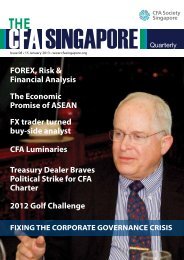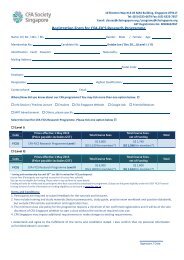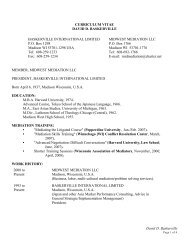Create successful ePaper yourself
Turn your PDF publications into a flip-book with our unique Google optimized e-Paper software.
The different types of fundsproviders allow your companyto draw on different maturityspectrums as well as a differentstyle of investment. The samegoes for geography. Findinginvestors outside of your homemarket is useful but difficult unlessyour name brand is known orthere is a credit rating.Investors invest in debt for differentreasons. Typically, they will wanta stable yield or some form ofrelative risk protection from equityvolatility. This is very attractive tosome issuers of capital who mustdiversify their exposure in order tomaintain the same spread of risksthat we are talking about here.Insurers, for example, need to puttheir premium monies to work.The premium collection periodsare usually long term and so willrequire a placement of funds thatis relatively long term. They toowant their revenue and expensecycles to match. This makes themsomewhat more risk averse thanan asset manager that may wantto take credit risk positions in shortterm maturities.Long-term debt for long-termrevenue and contract profileLengthening your debt structure isuseful if your revenue and contractprofile can be considered to be verylong. The idea here is to create amatching of the circumstances intiming of the debt repayments withyour revenue or cash flow stream.This will also greatly help inobtaining bank lines as mostinstitutions are very sensitive to thelength and duration of cash flowsat the source of their repaymentprofile. That is, if you can showa bank your revenue/cash flowstream is contracted for 10 years,you can (and probably should) intimes of uncertainty always obtain10-year financing.Long term debt financing may notalways be possible or advisableif a company has very short-termcash flow streams.(II) Protect CashFlowsTypically, this means ensuringthat cash flow IN is not subject torepricing in a down market andcash flow OUT is not subject torepricing in an up market.Believe it or not, this can bemanaged to some extent. This isNOT a formula for extending thetrade cycle of the organisation.What this means is:In a “down” market, give yourcustomers incentive to signlonger-term contracts. This willhelp in 3 ways.* Your customers are seeingthis as value add as they aresigning at lower rates.* As rates in the economycontinue down, our cashflows are still at “higher-thanmarket”levels.* Your liabilities managedbelow are repricing at lowerand lower levels relative toyour revenues.In an “up” market, give yourcreditors incentive to sign longerterm funding agreements, or justextend loans as the slowdownoccurs. This will work for yourcompany in 3 ways.* In an “up” market, interestrates will also rise. Thereforeit will cost more the longer youwait to extend duration/tenorof loans.* It will provide insulation frompotential shocks during aperiod of large growth in theeconomic cycle.* Your liabilities will have aconsistent level while yourrevenues continue to rise asprices reprice upwards butyour cost remains the same.Honestly, this is the most availableand practical form of downturnuncertainty management. As theevidence of slowdown continuesto show in various economicindicators, the MTI, the purchasingbehaviour of your customers, takethese steps, before the company’scommitments become skewed.Contracts to control futurerevenues and costsThe use of futures contracts isinteresting and is typically costfree at the outset. However, usingit locks you in to value. Futurescontracts exist in terms of interestrates commodities and otherforms of costs such as electricityand natural gas.The use of futures contracts allowsyou to sell or purchase such anunderlying asset at some point inthe future. Markets make longertenors available past 24 months inmost of these asset classes.This means you now have controlover what you will get paid forwhen you deliver a commodityin the future relative to what yourcustomers are saying. It alsomeans you will control the amountof expense that you have (in anup market) by buying the asset/commodity (electricity) in thefuture at a price known today.The problem with this is that themarket has already “priced in” anymovement in future prices today.So by entering into futures, youare effectively betting that yourview of the future prices is differentfrom the markets. Given the manyoperational issues being faced bymost companies, it is probablynot an efficient use of resourcesto look at these unless you aresignificantly exposed (>35% ofP&L) to commodities (e.g. airlinesto jet fuel).FP=CP[1+R D/360 ]whereFP = Future PriceCP = Cash PriceR = Repo Rate or Cost of CarryD = Number of days in a futurescontractPage11


